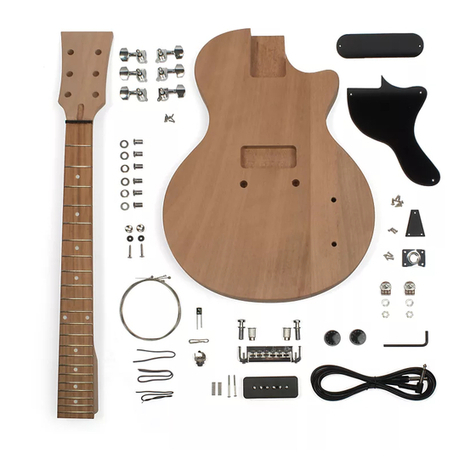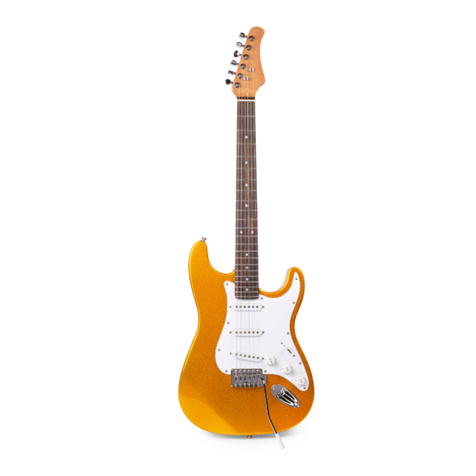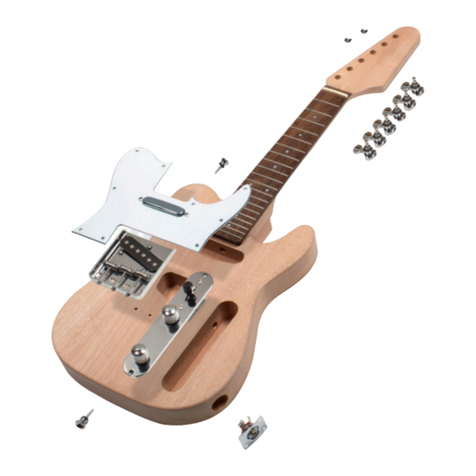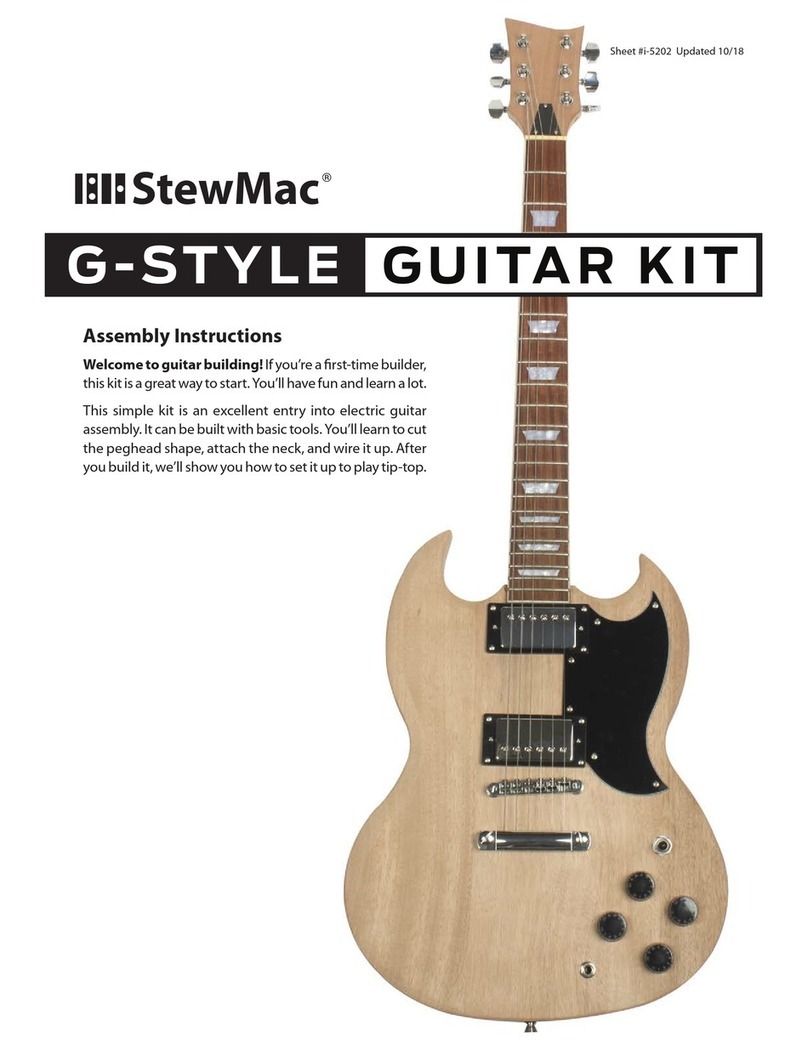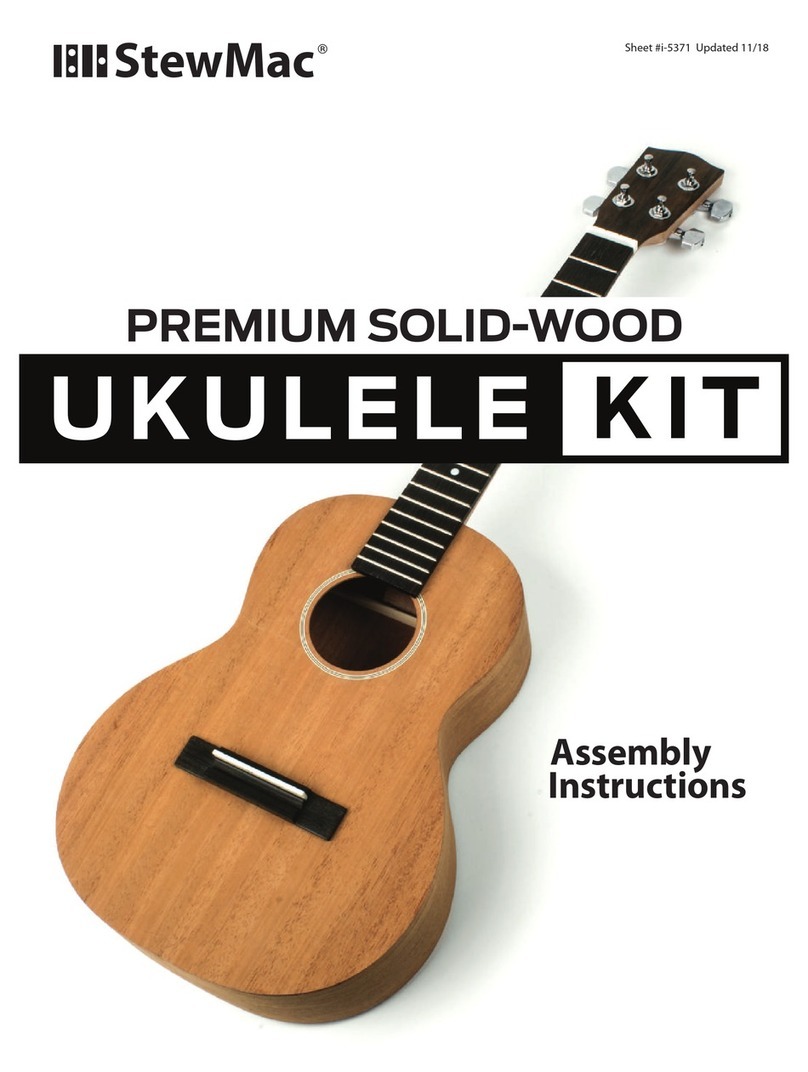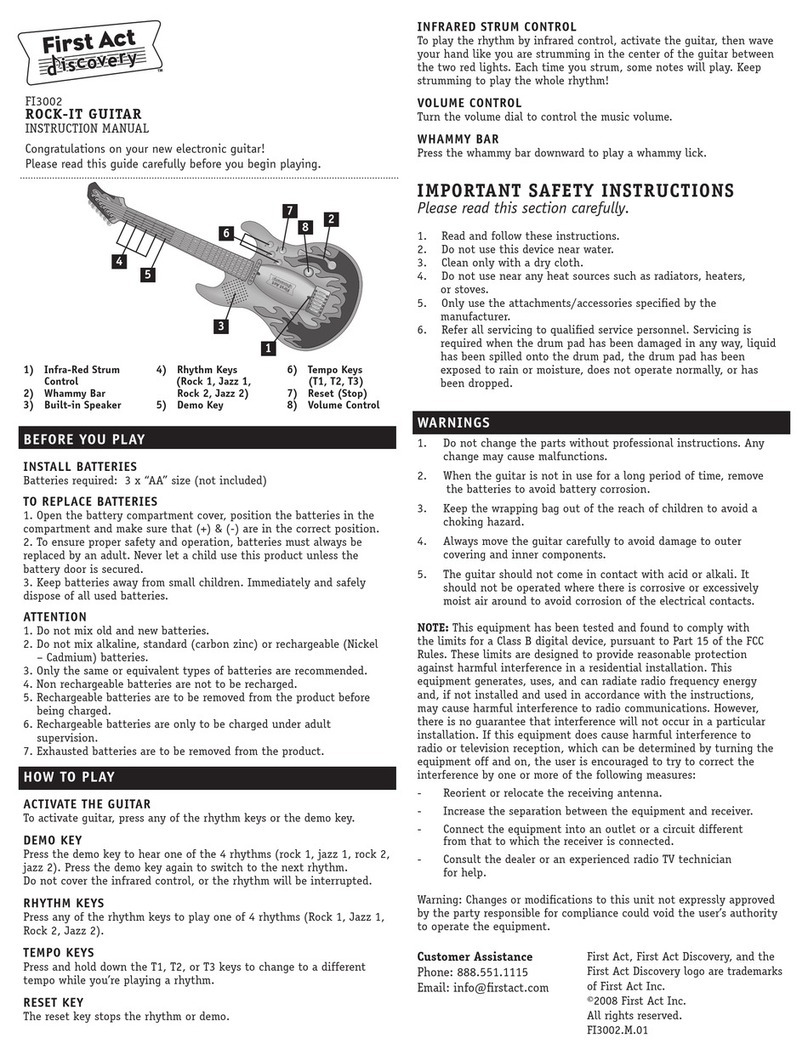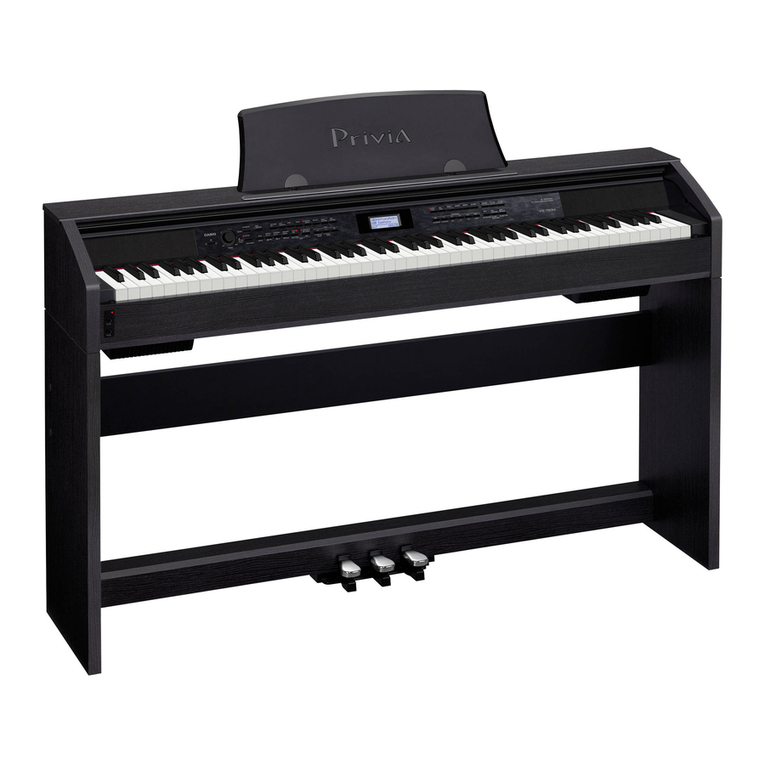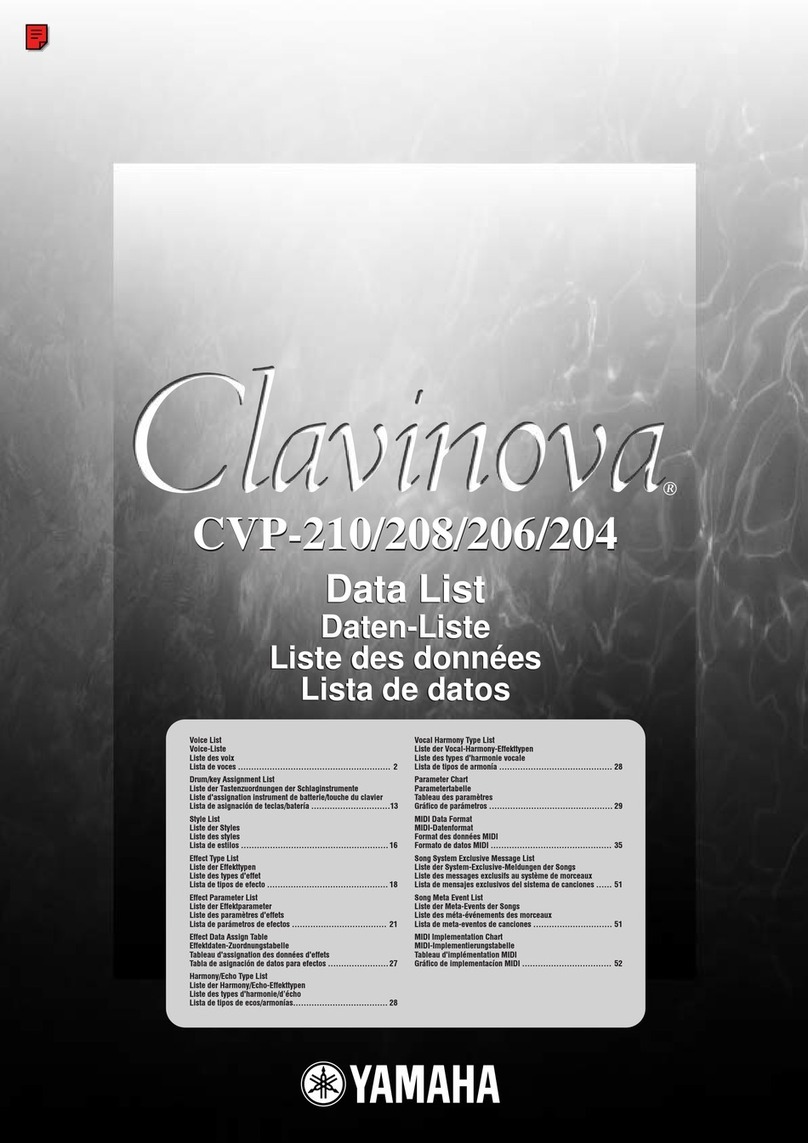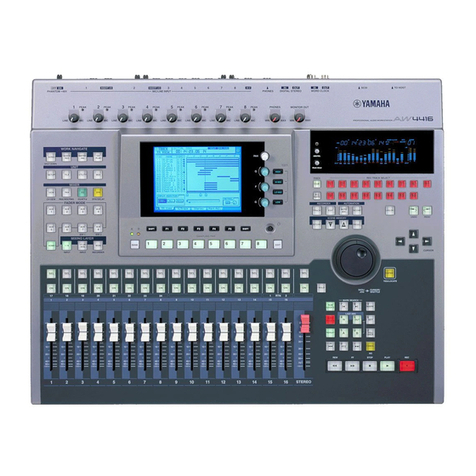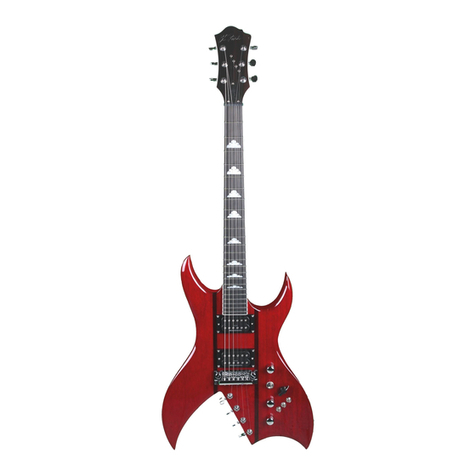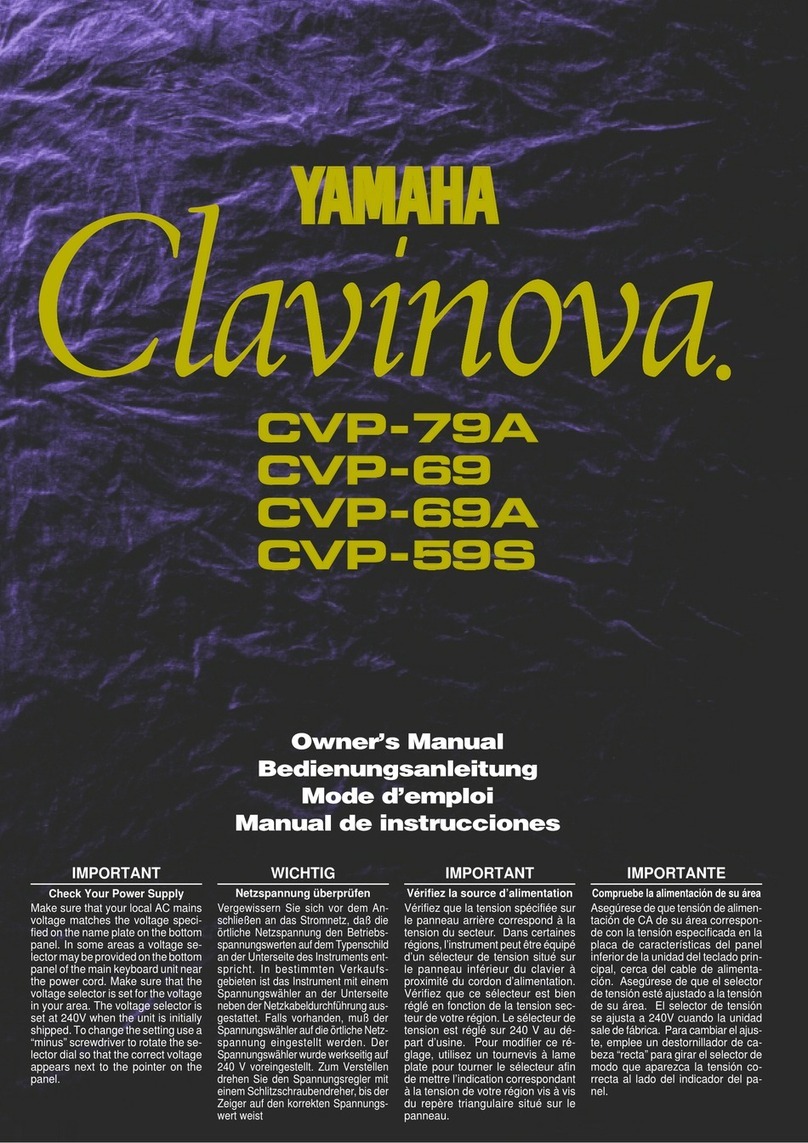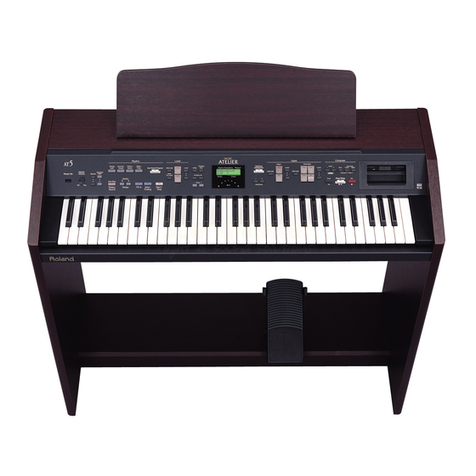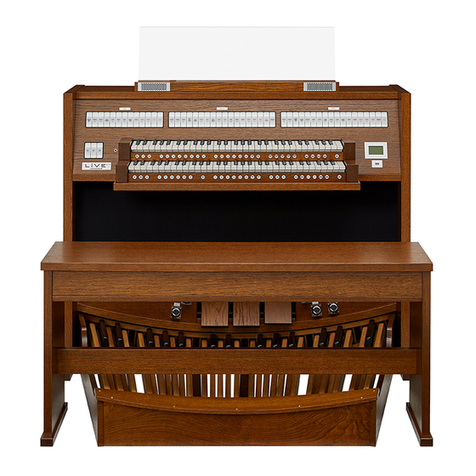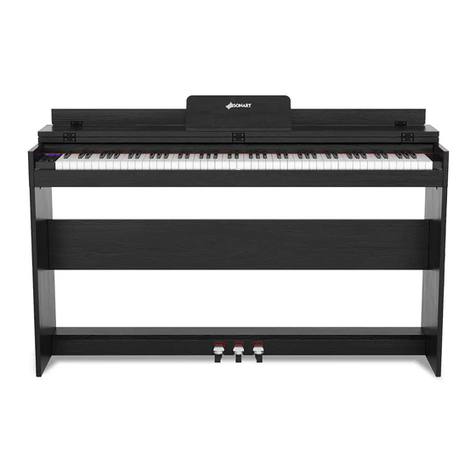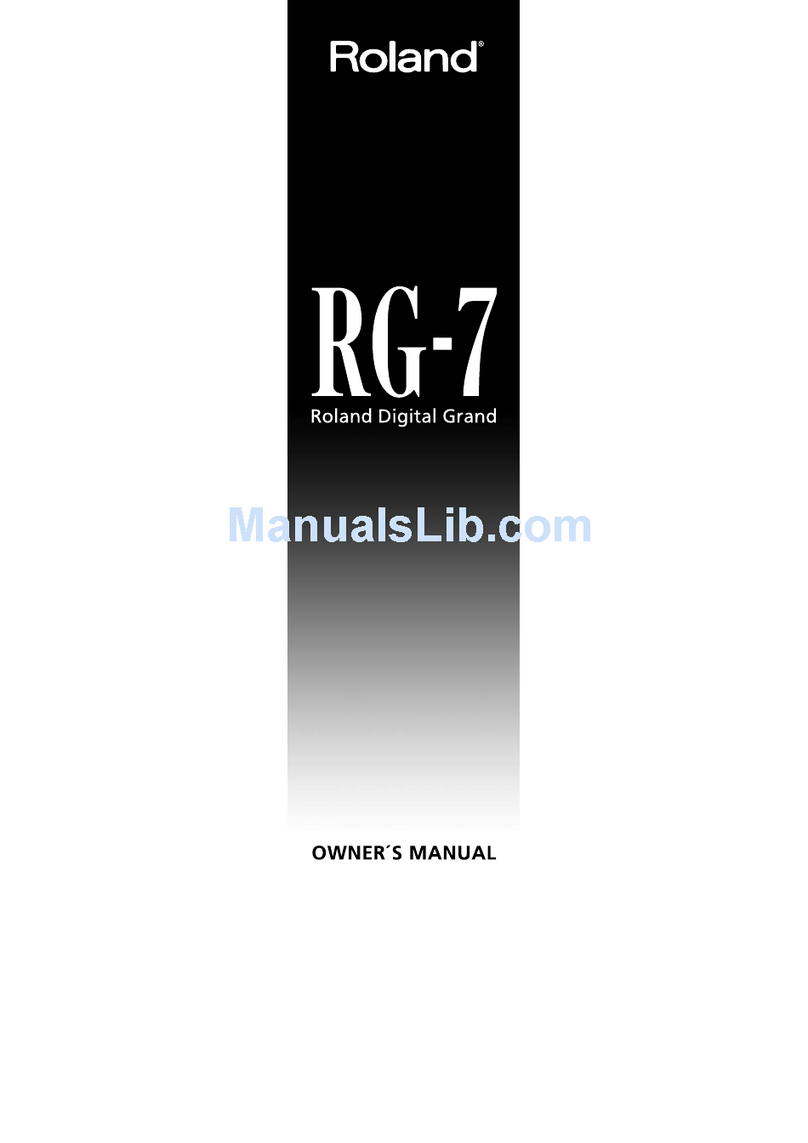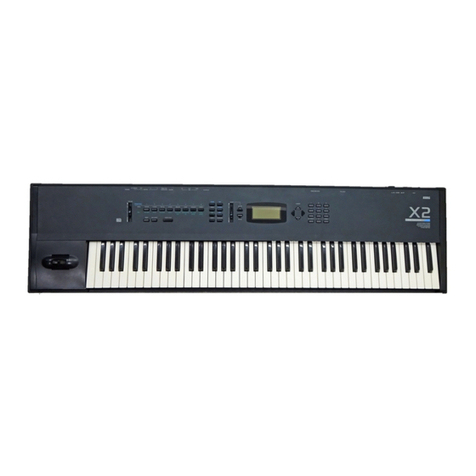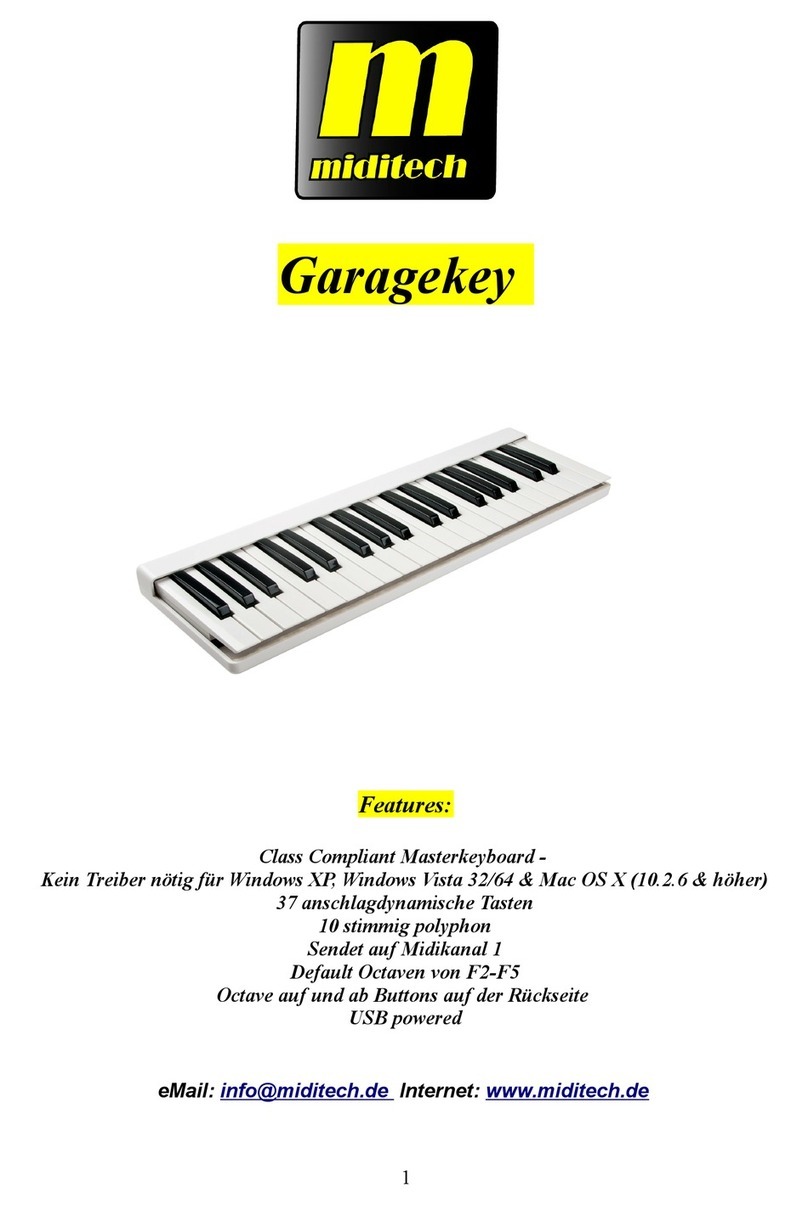StewMac I-5201 User manual

Sheet #i-5201 Updated 8/20
Assembly Instructions
Welcome to guitar building! If you’re a rst-time builder,
this kit is a great way to start. You’ll have fun and learn a lot.
This simple kit is an excellent entry into electric guitar
assembly. It can be built with basic tools. You’ll learn to cut
the peghead shape, attach the neck, and set it up. After
you build it, we’ll show you how to set it up to play tip-top.
*Exact parts and materials may vary.
StewMac
335 SEMIHOLLOW GUITAR KIT

stewmac.com
2
Tools and supplies ....................................
Parts list .............................................. 3
Create your peghead shape ........................... 4
Set the neck .......................................... 5
Fretwork ............................................. 7
Finishing ............................................. 8
Assemble your guitar ................................. 11
Wire the electronics ...................................13
Final setup ...........................................15
These are the tools and supplies we recommend for assem-
bling this kit. StewMac item numbers are included where
applicable.
Tools
Electric hand drill
Saw for peghead: band saw, jigsaw, or coping saw
Screwdrivers: Phillips, sizes #1 and #2 (#3000)
Flat blade, size 5.0mm (#3000)
Drill bits: 1/16" (#1710)
5/64" (#1712)
Nut slotting les: .013" width (#0823)
.020" width (#0828)
.035" width (#0832)
Fretting hammer (#4895)
Fret crowning le (#1602 or #4491)
Radius sanding block, 16" radius (#0413)
Swivel handle clamp, total of 2 (#3704)
Straightedge (#3850)
6" Steel rule (#4905)
Wire stripper, for ne gauge wire (#1606)
Adjustable wrench, 4" size (#1680)
Soldering iron (#0502 or #0515)
Supplies
Wood glue (Titebond original, #0620)
Sandpaper: 150, 220, 320, 400, 600-grit (#5562)
Stickit Gold sandpaper: 80-grit (#5766)
Solder (#0505 or #0505-LF)
Masking tape (#1683)
Low tack protective tape (#1863)
Glue brush (#4167)
3M Scotch-Brite pad (#7445, light duty), or 0000 steel wool
Blue permanent marker
ColorTone Lemon Oil (#3864)
Finishing supplies
There are many nishes and application methods to
choose from. We use ColorTone Aerosol Guitar Lacquers
because they’re easy to use and you can get a beautiful
nitrocellulose nish without investing in spray equipment.
ColorTone Waterbase Grain Filler, Neutral (#0220-N)
ColorTone Aerosol Guitar Lacquers:
1 can Vinyl Sealer (#3884)
1 can Aged Clear (#5887)
2-3 cans of Clear Satin (#3882)
Tools and supplies
Table of contents

stewmac.com 3
Parts list
Neck
Body
4mm hex wrench for adjusting truss rod
Tuners with bushings, washers, and screws (6)
Strap buttons, with washers and screws (2)
Generic strings for preliminary setup
(Also included: higher quality strings for actual use)
Capacitors (2)
Output jack
3-way toggle switch
Humbucker pickups with mounting rings (2)
Truss rod cover with mounting screws
Control knobs (set of 4)
Control pots with mounting hardware (set of 4)
Bridge with posts and bushings
Tailpiece with posts and bushings
*Exact parts and materials may vary.

stewmac.com
4
You can trace a favorite peghead or come up with a look all
of your own. You’ll be cutting your design from the blank
peghead on the kit’s neck.
Make a template
Sketch out your peghead design on a piece of cardboard
or heavy paper and cut it to shape with scissors. Using a
pencil, trace the shape onto the peghead. Use a light touch
that doesn’t dent or compress the wood which could make
sanding out any unwanted lines dicult. Don’t use ink,
because it leaves permanent stains that can even bleed up
through an opaque guitar nish.
Cut the shape
It’s important that your saw stays square to the face of the
peghead while you cut. If it tilts to an angle, you’ll get a
sloppy result that takes a lot of sanding to correct. Use a
bandsaw if you have one; a jigsaw is also good. A hand-held
coping saw can also be used, but it’s tough to hand-saw
smooth clean curves.
Never cut on the line
Always cut just outside the line, so you can sand to the line
afterward.
Smooth your saw cuts to create your peghead shape using
rasps, les and sandpaper. Don’t rush: rough patches will
disappear into a good nal shape if you take your time.
When you’re happy with your peghead shape, sand the cut
edges smooth using 150-grit sandpaper followed by 220-
grit, then 320-grit.
Create your peghead shape

stewmac.com 5
Neck set
Before gluing up the neck do a dry run rst. Using a single
clamp with cauls on the fretboard and back of the body to
prevent denting the wood, lightly clamp the neck into place
Note that there will be side to side movement of the neck.
There will be some gaps and chips around the joint; this is
normal for a production guitar. These will get lled when
you prep for nishing.
Take a 12" ruler or straightedge and line it up along the treble
edge of the neck, paying attention to where it falls in relation
to the treble side bridge stud hole. Then line it up with the
bass side of the neck and check it to the bass side stud hole.

stewmac.com
6
Loosen the clamp just slightly and adjust the side to side
position of the neck until you have even space between the
bridge mounting holes. When achieved tighten the clamp
securely. Mark a line in the cavity and on the tenon to use
as reference when gluing up the neck.
Make note of your actual gluing surface and spread glue on
the bottom of the tenon. Repeat the same process as above
using your reference line to get you in the ballpark. When
properly aligned tighten up a clamp on the tenon and one
over the end of the fretboard again using cauls to prevent
damaging the frets and body.
Once the neck is seated remove any excess glue squeeze
out with a damp cloth. Watch for further squeeze out over
the next 15-30 minutes.
Let dry overnight.

stewmac.com 7
Fretwork
Run your ngers lightly along the edge of the fretboard
and feel for sharp fret ends. If the fret ends feel sharp where
they meet the edge of the neck, gently sand them back with
320-grit sandpaper using long strokes down the length of
the neck. Use care not to change the bevel of the frets in
the process.
Straighten the neck
Use the 4mm hex wrench to adjust the truss rod. With a
straightedge on the frets, adjust the truss rod until the
straightedge touches all of the fret tops without rocking.
Turn the truss rod nut counterclockwise (viewed from the
peghead end) to loosen the truss rod, allowing the neck to
bow upward. Turning it right tightens the rod, pulling the
neck back.
For more information, see our Trade Secrets article “Don’t
be nervous about adjusting that truss rod!” at stewmac.com.
stewmac.com search: ts0033
Seat the frets
The frets come installed, but they need a little work to
achieve the best playability. Use a fretting hammer to make
sure the frets are all seated properly. The more even your fret
tops are, the less leveling work there is to do later.

stewmac.com
8
Wipe the neck with a damp cloth to raise the grain. After it’s
dry, sand it again with 320-grit.
Breaking edges
Slightly break any sharp edges on the fretboard, peghead
and body. Softening hard edges promotes even nish cover-
age. Later, when you’re lightly sanding out your nish, these
edges are less likely to sand through to bare wood.
Degrease with naphtha
When you’ve nished sanding, wipe the body and neck with
a naphtha-dampened rag to remove any oils or grease. From
this point on, wear clean gloves when handling so you won’t
contaminate the wood.
Tape o the string nut and fretboard face before applying n-
ish. Any overspray can be removed after the nish has cured.
Tip! Temporarily install an eye hook where the lower strap
button will be, this will serve as a hanger that conveniently
holds the guitar for nishing and while the nish cures.
Preparing the neck and body for nish is just as important if
not more important than the nal spray. The key to a great
looking nish is patience and lots of it. Be thorough with
your sanding and follow the nishing schedule on page 6
for best results.
Inspect the body and neck for any dents, chips, or other
imperfections and repair them. Small dents can be steamed
out by placing a damp cloth over the dent and applying
heat with a soldering iron. Chips and knotholes will need
to be lled.
Fill the grain
The body of a 335 style guitar is usually made with a laminat-
ed tight grained wood such as maple. The necks are often
made from an open grained wood like mahogany. Open
grained woods need to be lled before nishing in order
to achieve a at surface. Look your kit over closely to de-
termine what types of wood your kit was constructed with.
As a general rule, if you can see the pores of the wood with
the naked eye, you should use grain ller before nishing. If
needed, we suggest using our Neutral ColorTone grain ller
following the instructions on the label. Three applications
are recommended to get a nice at surface to build nish
coats over. The grain ller can also be used to ll any gaps,
chips, or other imperfections in the wood.
For more information on grain lling, see our article “Using
ColorTone Grain Filler” at stewmac.com.
Sand the body
The gured laminated woods on the top, back, and sides are
very thin and can easily be sanded. Using 320-grit sandpa-
per on a foam sanding block, lightly sand the entire body
working only in the direction of the grain.
After a complete sanding, wipe the body with a damp cloth
to raise the grain, to reveal bers that need more sanding.
Let the dampness dry, then sand the raised grain again using
320-grit sandpaper.
Sand the neck Sand the neck with 220-grit followed by 320-
grit. If your kit has a laminate on the peghead face, sand it
lightly with 320-grit using care not to sand through.
Run your ngers lightly along the edge of the fretboard and
feel for sharp fret ends. If the frets feel sharp where they
meet the edge of the neck, gently sand them back with long
strokes down the length of the neck. Use care not to change
the bevel of the frets in the process.
Finishing
Spray the nish
There are many nishes and application methods to choose
from. In creating these instructions, we’re using ColorTone
Aerosol Guitar Lacquers. These aerosols are a fast way to
build a quality nish.
Using a clear satin topcoat is recommended, because satin
doesn’t require much sanding or bung the way gloss
does. If you choose to spray a glossy nish, it will involve
more steps.
A brushed-on nish like tung oil, waterbase lacquer, or
shellac works great too. Any of these nishes will seal and
protect the wood from dirt and moisture.
stewmac.com search: i-5035

stewmac.com 9
The best advice for nishing: practice on scrap!
Test your nish of choice on scrap wood rst, so you can see
what you’ll get before applying it to your guitar.
Use warm lacquer, not cold. Professional nishers spray
heated lacquer because cold lacquer spatters, requiring extra
sanding. Warm up your aerosols before spraying by placing
the cans in a sink of warm tap water.
When spraying, keep the spray parallel to the surface of the
guitar for even coverage as shown below.
Spray schedule with ColorTone Aerosol Lacquer
This nishing process can be completed in as little as three
days, followed by a week of curing. Remember that patience
is the key to a successful nish job. Don’t rush it! Spray the
lacquer using light passes to prevent runs.
Day 1
Body and neck: Spray 1-2 coats of aerosol Vinyl Sealer on
the body, waiting 1-2 hours between coats. Next, spray 1-2
coats of Aged Clear lacquer, waiting 1 hour between coats.
Let dry overnight.
Day 2
Body and Neck: Spray 3-4 additional coats of Clear Satin, 1
hour apart.
Allow to dry overnight.
Day 3
Body and Neck: Lightly sand the body and neck with 400-grit
paper to remove any nish spatter or dust.
Spray 3-4 additional coats of satin clear, 1 hour apart.
Allow the nish to cure for a week in a cool, dry room. Around
70° at 50% humidity is recommended.
After the nish has dried for 1 week, go over the entire
instrument lightly with Light Duty 3M Scotch-Brite Pads or
0000 steel wool for a nice satin appearance.
The right way to spray: Move in a straight line, so the distance
from the work stays the same. This gives you even coverage.
Keep your
wrist flexible
Stiff wrist
The wrong way: Swinging in an arc moves the spray closer and
farther from the work. Center coverage is heavy, edges are light.

stewmac.com
10
Use adhesive backed sandpaper or double-stick tape to
attach 320-grit sandpaper to the 16" radius sanding block.
With this, level the frets using full length strokes down the
fretboard.
Leveling will leave at tops on the frets. Use a fret crowning
le to restore their rounded shape.
Reapply blue marker to the fret tops. By ling the sides of the
frets, bring in the edges of the ats left over from leveling.
With a rounding motion, keep bringing in these edges until
all that remains of the top is a very thin line. Don’t remove
this line entirely; ling the fret tops would undo your leveling.
Polishing the frets
Using 400-grit, then 600-grit sandpaper wrapped around
a foam block, run up and down the entire length of the
fretboard. Polish the frets by going over each one with extra
ne Scotch-Brite or 0000 steel wool.
Color the fret tops with a blue permanent marker to prepare
them for leveling. The blue ink will show your progress: the
frets are level when sanding has removed some of the blue
across all of the fret tops.
Level the frets

stewmac.com 11
Assemble your guitar
Assemble your guitar on a soft pad or cardboard to prevent
denting or scratching the instrument.
Install the tuners
Starting with the bottom set of pegholes, lay out the tuners
with a ruler to make sure they are in line with one another.
Mark out the mounting holes with a scribe or transfer punch.
Tuner mounting screws are very delicate. Use a 5/64" drill
bit to make pilot holes for the screws; if these holes are any
smaller you risk shearing o the screw heads. Lubricate the
screw threads by dragging them across soap or wax for
smooth installation.
With the tuners in place, install the screws in the pilot holes
with a #1 Phillips screwdriver. On the tuner string post, add
a washer then the threaded bushing. Tighten with a 10mm
nut driver or wrench.
Install the body bushings
Install the tailpiece bushings. It’s a good idea to slightly
chamfer the holes for the bushings to prevent chipping
or lifting the nish. Cut the edge back just larger than the
outside diameter of the knurling.
Note that there is a small hole running from the treble side
hole running into the control cavity, this is for the string
ground. The 7" ground wire needs to be installed before the
bushing. Strip 1/2" o of both ends and run the wire through
the hole into the cavity leaving the stripped end to come in
contact with the bushing once installed.
Install the tailpiece bushings. Pressing them in with a drill
press is the preferred method but they can also be installed
with gentle hammer taps using a block of wood between
the bushing and hammer.
Install the bridge bushings in the same fashion.
Bushing hole
before chamfering
Bushing hole
with chamfer
Ground wire
in bushing hole

stewmac.com
12
Install the strap buttons
Mount the tail strap button. The top button screws into the
back of the body, just beyond the heel. Drill a 3/32" hole,
1/2" deep.
Install the pickups
Your kit has two humbucker pickups. The bridge pickup
has a taller pickup ring and wider pole piece spacing. The
neck pickup has a shorter pickup ring and tighter pole piece
spacing. The bottoms of the pickup rings will need to be
sanded to match the contour of the top of the guitar. If your
pickups came installed in the mounting rings you will need
to remove them temporarily while you perform this task.
Use a pencil cut in half lengthwise to transfer the contour
of the top onto the pickup ring. This process is shown on a
dierent guitar, but the operation is the same on your build.
Anything that falls below the pencil line on the pickup ring
needs to be removed. Place low-tack tape over the top of
the guitar to protect it. Using 80-grit, Stickit Gold sandpa-
per sand front to back (the direction of neck to bridge), not
side to side to match the radius of the top. While this will be
slower, it will give you the true radius and a better tting
pickup ring. Keep in mind the contour of the bridge pickup
area is slightly dierent than the contour of the neck pickup
area. For more tips about modifying pickup rings to t an
arched top guitar, see our Trade Secrets video “Fitting a Les
Paul ring”.
stewmac.com search: ts0192
Once the rings are tted drop the pickups into their cavities.
Remember, the pickup with the wider pole spacing is the
bridge pickup, the pickup with the tighter pole spacing is
the neck pickup.
Install the tune-o-matic bridge and tailpiece. String up the
low and high E strings from the generic string set, to use as
reference.
Line up the neck pickup so it is square to the end of the
fretboard and the E strings are evenly above the polepieces.
Mark the locations of the holes.
Now carefully line up the bridge pickup to make sure it is
square to the neck pickup. After you've marked the holes,
remove the strings and pickups. Then drill the holes with a
1/16" bit, 3/8" deep. Install the pickups.

stewmac.com 13
Wire the electronics
stewmac.com search: ts0186
If your kit came with a prewired harness, wire the pickups to
the pots and the output to the jack as shown in the wiring
diagram.
If your guitar came with a parts kit, make a cardboard tem-
plate that matches the hole pattern of the controls for proper
parts spacing and easy soldering. Peel the wires apart and
cut to length giving yourself a little slack between compo-
nents. Strip about 1/8" of the insulation o of the ends of
each wire, twist each end tight then coat them with a little
solder; this is called “tinning”. Tinning the wire ends as well
as the lugs on the switch, pot, and jack will help your solder
joints ow together quicker and cleaner.
Solder up your circuit following the wiring diagram to the
right.
For help with soldering, see our Trade Secrets video “How
to get a good clean solder joint!” at stewmac.com.
Output
jack
Toggle
switch
Neck
Out
Bridge
Ground
Ground
to bridge
Neck
V
Neck
T
Bridge
V
Bridge
T
.022μF
.022μF
Neck Bridge
NV
BV BT
NT

stewmac.com
14
Install the harness
There is not cavity access on this guitar, which means you
will need to feed the components in through the treble side
F-hole. Fish the neck and bridge leads and string ground out
of the body and solder them in place following the diagram.
Once soldered it's time drop the controls into the guitar and
then up through the mounting holes. This is a tricky job, our
#0255 Archtop Helping Hand and #0107 Jack Installation tool
make easy work of it. Another method is to rst tie strings or
rubber bands to the shafts of the pots and switch and pull
them up through the mounting holes. For help with this
technique, see our Trade Secrets article “Fishing a volume
control out of a semi-hollowbody for soldering.”
Once the switch, jack and pots are secured install the knobs.
stewmac.com search: ts0094

stewmac.com 15
Final setup
Adjust the neck
Install the remaining generic strings.
Neck relief refers to adjusting a neck so that it has a very slight
upbow, rather than being perfectly straight. This relief allows
a little more room for string vibration, reducing the chance
of hitting the lower frets and causing fret buzz.
Depending on your playing style, and how perfectly level
your fret tops are, a neck should be anywhere from perfectly
straight to having 0.012" of relief. This measurement refers
to additional string height over the 12th fret, compared to
a perfectly straight neck.
A straight neck tends to play and sound better, but very few
guitars end up with no relief at all, and several thousandths
of an inch or more is perfectly normal.
You can use a straightedge or the low E string to get you in
the ballpark. Using your index nger, hold down the E string
at the rst fret. With the other hand, hold down the string at
the 17th fret with your thumb and use your index nger to
check for relief. The smaller the gap between the bottom of
the string and the top of the frets, the straighter the neck.
Lower the nut slots
Once the neck is adjusted to the desired straightness, the
nut slots will need to be lowered for the best playability.
Measure the gap between the bottom of the string and the
top of the 1st fret.
A comfortable medium action over the rst fret is .012" for
the plain strings (G,B,E), and .020" for the wound strings
(E,A,D).
Use feeler gauges to measure the gap or use guitar string
scraps whose gauges match the measurement you are shoot-
ing for. Using just a few le strokes at a time, stop ling when
the string sits on the top of your feeler gauge, whatever it
may be. Take your time and check your work frequently. It
is easy to go too far lowering the slots thus ruining the nut.
Turn the truss rod nut
counterclockwise to bring
the neck up, adding relief.
Measure string relief
at the 12th fret.
Turn clockwise to pull the
neck back, reducing relief.
Go slow: a little does a lot!

stewmac.com
16
Set the string height
Adjust the bridge action using the thumbwheels on bass and
treble sides. Measure the gaps between the bottom of the
low and high E strings and the top of the 12th fret.
Factory action for the high at the 12th fret is 1/16" for the
high E string, and 5/64" for the low E.
Set the intonation
The last step is intonating the guitar by adjusting the string
lengths at the bridge saddles. This will help ensure that the
guitar plays in tune all the way up the neck.
Remove the generic strings and install the higher quality set.
Tune the strings to pitch using a strobe or other accurate
tuner. Then, press the high E string lightly at the 12th fret
with just enough pressure on the fret to sound the note.
Check it with your tuner.
If the note reads at, the saddle needs to be adjusted forward
towards the nut, shortening the length of the string. If the
note reads sharp, the saddle needs to be adjusted back away
from the nut, increasing the string length.
Adjust the pickup height
One at a time, hold the low and high E strings down at the
22nd fret.
Adjust the neck pickup to 1/16" between the bottoms of the
low and high E strings and the top of the pole pieces. Adjust
the bridge pickup to 3/32".

stewmac.com 17
You’re done!
Congratulations!
Your guitar is ready to play. We hope this guitar will
be the rst of many that you have fun assembling and
customizing.
Be sure to get a gig bag or case, so it doesn’t get banged
around!


21 N. Shafer St • Athens, Ohio 45701 • USA
USA & Canada call toll-free: 800-848-2273
9am-6pm weekdays Eastern time
stewmac.com
Table of contents
Other StewMac Musical Instrument manuals

